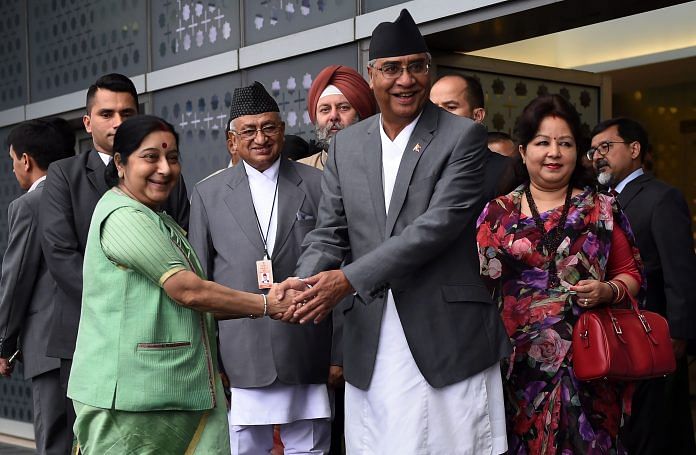In a month or so, none of the political figures Sushma Swaraj meets in Nepal will remain what they are now – Oli, Prachanda, Deuba or even President Bhandari.
Two months after the general elections, Nepal still waits for the formation of a fully functional government.
When India’s Minister of External Affairs Sushma Swaraj arrived on a whirlwind tour of Kathmandu in the afternoon of 1 February, the only person with a sure position was her own ambassador Manjeev Singh Puri.
She began her 24-hour stay in Nepal by dining with Communist Party of Nepal (United Marxist-Leninist) supremo Khadga Prasad Sharma Oli; she is slated to breakfast with Communist Party of Nepal (Maoist Centre) chief Pushpa Kamal Dahal the next morning, attend a tea reception being hosted by President Bidya Bhandari a little later, and lunch with Prime Minister Sher Bahadur Deuba before heading home in the afternoon.
But in a month or so, none of the political figures she meets will remain what they are now.
There is a reason Swaraj chose to hold talks with UML chief Oli first. He is the unchallenged leader of the Leftist coalition and is likely to be the next Prime Minister in a month or so. Dahal, or ‘Prachanda’ as he’s commonly known, runs his party almost singlehandedly and will be the second most powerful person of the government that is likely to be formed.
Bhandari may wish to be retained as the President for the next term. But the competition for high posts in the UML is fierce. Supremo Oli may decide that the position can be useful to kick one of his competitors in the party upstairs and ensure his longevity. Clinging to the post due to an electoral technicality, premier Deuba is mostly likely to be the leader of the opposition in the new House after a month.
That is the most likely scenario if everything in politics runs its normal course. But normality is seldom expected in Nepalese politics. There is a saying in Nepali, which means that ‘a long night lets cinders burn bright again’.
Constitutional complexities
In the immediate aftermath of the earthquakes of 2015, the Nepalese Constitution was ‘fast-tracked’ without the required consultations or proper deliberations. Its drafters forgot to clarify inter-relationships between different clauses of the statute.
The result is that even though the Nepali Congress lost parliamentary elections, its leader isn’t just a caretaker head, but the legitimate Prime Minister with full authority. Complexities of the mixed electoral system have made that anomaly normal.
According to Part 8 of the Constitution of Nepal, the Federal Parliament is composed of a 275-member Lower House (the House of Representatives) and 59-member Upper House (the National Assembly). Out of 275 members in the House of Representatives, 165 are to be elected according to the first-past-the-post system. The other 110 come from a proportional list of competing political parties.
Political majority in the Lower House is the basis for forming the government.
Direct elections for the House of Representatives were held in two phases and concluded in early December 2017. According to its results, CPN (UML) emerged as the largest party, winning 80 of the 165 first-past-the-post seats. Its electoral ally, the CPN (Maoist Centre) garnered 36 seats. Together, they have a clear majority.
However, there is slight hitch—the Constitution requires that the composition of the Federal Parliament must conform to inclusion laws such as the provision that at least one-third of the total members elected from each political party in the Federal Parliament must be women. In order to declare final results, the Election Commission has to wait for the formation of the National Assembly.
Since the electoral college of the National Assembly is dependent upon the formation of provincial assemblies and proportionate representation of political parties in the House of Representatives, presumptive PM Oli can do nothing to rush the process of his anointment as the head of government for the second time.
Coalition quandary
In addition to the electoral conundrum, there is yet another reason Oli has to unnecessarily cool his heels. On its own, the CPN (UML) doesn’t have a clear majority in the House of Representatives, and has to rely upon its electoral ally to form the government. The electoral ally, the CPN (Maoist Centre), is turning out to be a tough customer.
Up until the local elections in May and the election of premier Deuba soon afterwards, the CPN (Maoist Centre) was the coalition partner of the incumbent government. Prachanda put one foot in the Left Alliance in October 2017, but refused to recall his ministers from the cabinet and retained the other foot in the government.
It seems Prachanda was hedging his bets and keeping his options open. His options remain open. It’s still possible for him to have a go at the top post if all other parties are to band together to keep the CPN (UML) out of office.
The rumour mill in Kathmandu has it that his Indian interlocutors have refused to assist him in exploring all such possibilities. His best chance now is to bargain for as much stake in the future coalition as possible.
Swaraj’s diplomacy
It seems Swaraj was well-briefed before her Kathmandu trip. Soon after her arrival at the Tribhuvan International Airport, she told the media: “I am here to meet my friends. I am not here with any agenda.”
Even if she had an agenda, she wouldn’t really be sure who to discuss that with. It will take at least a month more before a new government is formed in Kathmandu. The clearest message from Swaraj was perhaps that she had no message to deliver. Nepalese politicos have to sort out their own mess.
CK Lal is a columnist, commentator, and playwright. He has written about arts, books, industry, economy, culture, society, politics, and international relations.






